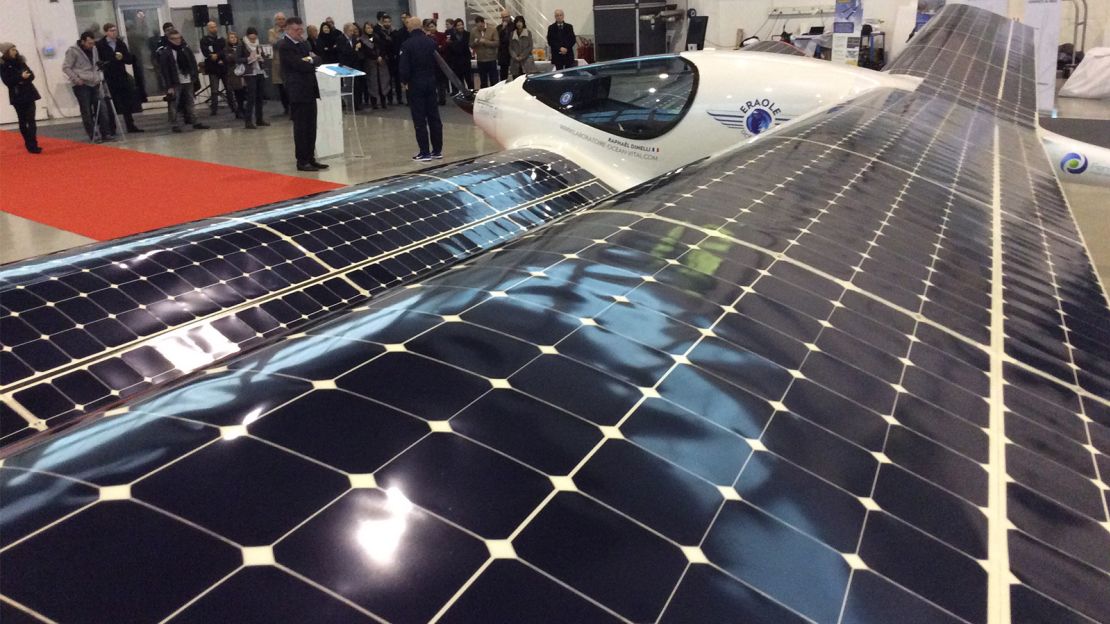Editor’s Note: For more innovations that let us experience the world in thrilling new ways, go to cnn.com/adventure
The French town of Les Sables d’Olonne is no stranger to ambitious missions to harness the forces of nature.
It’s best known as the departure and arrival point of the Vendee Globe, the notoriously tough round-the-world nonstop solo sailing race.
Maybe that explains why it’s here, far from the world’s major centers of aircraft manufacturing, that a team of visionaries is readying a ground-breaking new aircraft concept.
And why they’re being led by scientist and former yachtsman Raphael Dinelli, a four-time veteran of the Vendee Globe.
The team’s plan is to make the first carbon-free transatlantic flight a reality by June 2016.
The quest for the electric plane
While the car industry is already transitioning away from fossil fuels, commercial aviation is lagging behind.
Not for want of attempts.
The first tangible steps towards carbon-free flight echo the efforts of the first aviation pioneers a century earlier.
In July 2015 two competing electric aircraft flown by Frenchmen Didier Esteyne and Hugues Duval crossed the English Channel within hours of each other, a technological feat not unlike their countryman Louis Bleriot’s celebrated 1909 cross-Channel flight.
Future of Adventure
Dinelli and his team at eco-science research body Fondation Ocean Vital have set their sights on a more ambitious milestone – the non-stop transatlantic flight in a completely carbon-free aircraft.
What is the Eraole?

They’ll be attempting it in the Eraole: A hybrid, solar and biofuel-powered light biplane aircraft that’s been in the making since 2009.
It’s powered by an electric engine fed by large solar panels spread over its wings.
At night, or at times when the aircraft can’t draw enough energy from the sun, the Eraole switches to biofuel.
Dinelli and his team have spent two years researching the best biofuel for the task, settling finally for an oil made from micro-algae, cultivated specifically for this purpose.
Overall, the Eraole’s expected to run on solar power for about 25% of the time it’s airborne.
Another 55% will be powered by biofuel, while gliding will account for 20%.
Composite materials have been used extensively to lighten the weight.
The aircraft’s also equipped with small lithium-ion batteries that provide extra power during take-off.
The Journey
While the Eraole is a high-endurance aircraft, its solo crossing of the Atlantic will present its the pilot with physical challenges not unlike those face by Charles Lindbergh when he made the first ever nonstop transatlantic flight in 1927.
The Eraole’s average speed of around 100 kilometers per hour means Dinelli will be stuck in its tiny cockpit for nearly 60 hours.
There’s no autopilot to fall back on and, because he’ll be in an unpressurized cabin at about 10,000 feet, he’ll be breathing air with almost 30% less oxygent than normal.
Dinelli isn’t too worried about sleep deprivation.
His 25 years of experience as a solo sailor have taught him how to manage sleep cycles and carry on for long periods by just taking regular micro-naps, a few minutes of sleep at a time.
What worries him most is the lack of mobility in the small cockpit, which will affect circulation in the legs.
To prepare his body for the challenge he’s embarked on a rigorous training program that includes long-distance running and trekking on glaciers.
The goal is to be completely ready by June 2016 – exact date still to be confirmed – when the Eraole is expected to take off from North America on its eastward journey.
The way ahead
While we may still be quite far from an entirely carbon-free industry, the experience accumulated in these experimental flights may speed up the adoption of solar power and biofuels in aviation.
Some segments of it may go carbon-free much sooner.
The Eraole is itself a case in point.
Far from being a one-off wonder, if successful, a serially-produced two-seater version of this light aircraft may soon be launched for the private recreational market.
It’s a small step towards carbon-free skies
But what’s certain is that, as Dinelli puts it, “People investigating non-carbon flight are no longer seen as a bunch of eccentric dreamers.”
Miquel Ros is an aviation blogger and consultant. An economist by background, he’s worked for Flightglobal and Bloomberg. He currently covers the airline industry through Allplane.tv and collaborates with luxury travel website Trovel and other online media.










